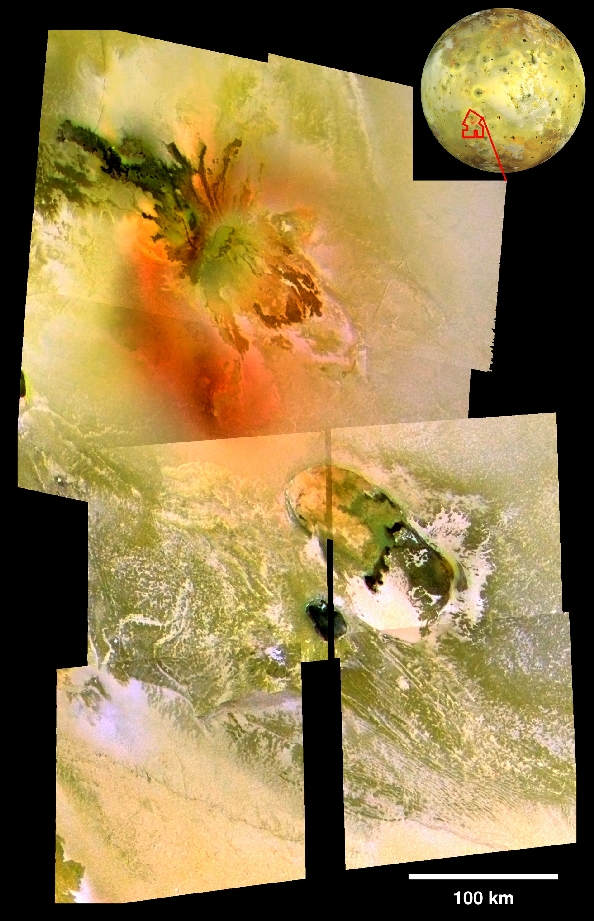

Repeated flybys of Io by NASA's Galileo spacecraft have allowed scientists to develop an understanding of Io's Tohil-Culann region of interconnected volcanoes and mountains.
An active volcano named Culann Patera (top center) is one of the most colorful volcanoes on Jupiter's innermost large moon. It lies just north of an enigmatic mountain called Tohil Mons. This mosaic image uses high-resolution Galileo images of Culann (200 meters or 660 feet per picture element) from the November 1999 flyby and high-resolution images of Tohil (165 meters or 540 feet per picture element) from the February 2000 flyby and combines them with lower-resolution color images (1.4 kilometers or 0.9 miles per picture element) taken during the July 1999 flyby. Using the combined information, Galileo scientists have identified relationships among many colorful features in this complex.
The volcano Culann has produced both dark black and dark red lava flows, as well as diffuse, inner and outer rings of red and yellowish sulfur particles from explosive plumes (for example, Masubi). Molten silicate rock inside Culann must occasionally mix with subsurface reservoirs of sulfur and sulfur dioxide to produce the plume deposits. The green color at the center of Culann and inside the older volcano Tohil Patera (center right) forms when red sulfur plume deposits land on dark black silicate lava flows and form a green veneer. The large white patch in southwestern Tohil Patera is rich in sulfur dioxide, and comparison with higher-resolution views suggests that this might be a region of cold sulfur dioxide flows. The small white patches on the mountain Tohil Mons might be deposits of sulfur dioxide snow that accumulate in grooves and at the bases of steep slopes in colder areas on the mountain. At upper right is a global view of Io showing the location of the mosaic.
Although Tohil Mons rises up to 6 kilometers (19,700 feet) above Io's plains, it is difficult to see in this image because the Sun was behind Galileo at the time it was taken. The topography of the mountainous region is clearer in a mosaic of images taken when the Sun was low in the sky, with illumination from the right (below). The side-lit mosaic combines a high-resolution (330 meters or 1,100 feet per picture element) image from October 2001 with lower-resolution color images (1.4 kilometers or 0.9 miles per picture element) from July 1999.

North is to the top of all images.
Images produced by: David Williams, Arizona State University
and Moses Milazzo, Planetary Image Research Lab. (PIRL), Lunar and Planetary Lab. (LPL), University of Arizona
The Jet Propulsion Laboratory, a division of the California Institute of Technology in Pasadena, manages the Galileo mission for NASA's Office of Space Science, Washington, D.C. Additional information about Galileo and its discoveries is available on the Galileo mission home page at http://galileo.jpl.nasa.gov/. Background information and educational context for the images can be found at http://galileo.jpl.nasa.gov/images/io/ioimages.html.
NASA's Planetary Photojournal PIA-03885
6 December 2002